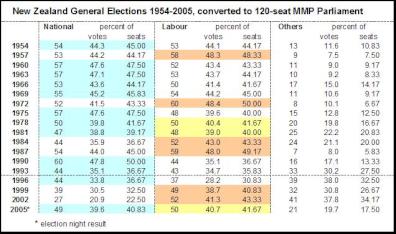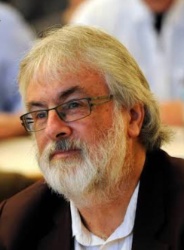The MMP Files [3]: Elections Past and Future.
By Keith Rankin
Entrenched two-party politics began in New Zealand in 1938, an inevitable though surprisingly delayed outcome of the FPP voting system. From 1938-51, the winning party actually got a majority of votes cast. It's never happened since.
The first serious "minor party" challenge came in 1954, following a couple of years of near-zero economic growth. The challenger was the Social Credit Political League.
In the 1930s, the heyday of "Douglas Credit", the Social Credit movement in New Zealand was aligned with Labour. In other words, the social credit monetary reformers were a faction within Labour. The schism happened in 1943, when the social creditors sided with JA Lee's breakaway party. Social Credit subsequently split with Lee, and contested the 1954 and all subsequent elections.
In 1954 Social Credit got 11% of the vote. This was clearly an anti-government vote. In 1957 some of the Social Credit voters wised up and voted Labour, leading to the toppling of the Holland-Holyoake National Government.
In the triennial elections of 1954-93, National became government 10 times, Labour 4 times. National on average scored 43.0% of the votes (43.7% if we exclude the years it was defeated). Labour on average scored 42.4%, with 46.9% being its average tally on the four occasions it was able to form a government.
Social Credit was the predominant minor party. Generally, the minor parties that reached 5% of the popular vote can be interpreted as more anti-National than anti-Labour, meaning that, under MMP, for most of those elections the left bloc would have been significantly larger than the right bloc. (The main exception would be Social Credit in the 1960s. By then Social Credit mainly attracted dissident rural voters who would never have contemplated voting Labour.)

Click for big version
The last 50-years general election results, with 1954-1993 FPP results converted to MMP, are summarised in the table above. Blue shading indicates a National win under FPP. Orange shading indicates a Labour win under FPP. Yellow shading indicates a National FPP "win" with Labour getting more votes than National. The 2005 election would have fallen into this category had it been fought under FPP.
National clearly benefited from FPP, forming most governments, including three with less than 40% of the vote. While National never got a majority of the vote in this period, in 1990 it would have gained 50% of the seats in an MMP election.
The table above clearly shows why many right-wing politicians and voters like the super-simple FPP electorate system that we stumbled upon in the 19th century.
Sometimes, National leaders had to be very adept at divide and rule politics. Robert Muldoon, a master of divide and rule, won one election (1975) with 47.6% of the vote. After that he couldn't muster 40%. The left fell into their usual trap of fighting each other rather than fighting National. 1978 was in reality a landslide defeat for National.
(1978 was the nadir of FPP voting. It was the closest to a gerrymander I've ever witnessed. The electorate boundaries of Gisborne and Wellington Central, to give just two examples, have the look of a classical Northern Irish gerrymander. National got 11 more seats than Labour, despite being nearly a whole percentage point behind Labour on the popular vote. It descended to farce with the Hunua electorate electoral petition. Huge swathes of votes in Hunua were declared invalid because: [i] voters used ticks or crosses instead of ruling out all the candidates they didn't want, [ii] they ruled out only party designations and not the candidates' names, or [iii] because they had moved to a new address in the same electorate. The election-night result was overturned. Winston Peters took his seat about 6-months after the election, making Labour's Malcolm Douglas - Roger's brother - an un-MP for six months.)
Social Credit became a conservative party in the 1960s, the days of the economic golden weather. In 1966 they did well; their leader (Vern Cracknell) even gained a seat in the far north. This was not a serious challenge to the Holyoake National Government; just a reminder not to take voters for granted. When Labour seriously challenged in 1969, the conservative Social Credit vote went back to National.
Social Credit then went through a major schism. It's right-wing contested the 1972 election as the New Democrats under Shannon farmer John O'Brien. It's left wing was led in 1972 by a young and telegenic Hamilton school-teacher, Bruce Beetham. After that, Social Credit can only be understood as a left-wing, anti-National party. It's membership of the Alliance from 1993 to 1999 - as the Democrats - attests to that.
In 1993, the National Government was defeated in a comprehensive landslide. There were almost two anti-National votes for each National vote. Yet, National was able to form a government, with 50 FPP seats out of 99. FPP went out on a note of complete democratic farce.
The 2005 election has taken us back to voting patterns that predominated prior to 1993; a close-fought contest between National and Labour, with 20% of the vote going to minor parties. Unusually, the minor party vote was more conservative than usual, reflecting six years of an incumbent centre-left government.
In an election system in which the popular vote matters - unlike elections filtered through electorates, electoral colleges and boundaries commissions - it is the party supported by the median voter that determines who will govern. In New Zealand the median voter has usually been a slightly left centrist. Hence, under MMP, Labour is the natural party of government.
MMP and FPP are fundamentally different in outcomes. Under MMP, New Zealand will have left-leaning governments about 75% of the time, because the centre-left bloc normally exceeds the centre-right bloc. Under FPP, with the same voters expressing the same preferences, National wins two-thirds of the time. In the future, we may see many Parliaments with just three or four parties. At times it will seem like a return to the FPP two-party system.
But the differences between MMP and FPP are fundamental, because the two systems yield different winners even in two-party contests such as 2005.
Further, under MMP, voters do not have to congregate against a single "devil you don't know" (as happened in 1990) in order to dismiss the "devil you do know". Almost any vote for any party opposed to a conservative government is an effective vote for change. Under FPP though, huge numbers of anti-conservative votes are ineffective, leading to a predominance of centre-right or right-wing governments.
Under FPP, small parties generally only got a look-in in by-elections. One unremarked upon feature of recent politics is how few of our MPs have died in office. (The last MP to die in office was, I believe, Basil Arthur in 1985.) With longer life expectancy than in the past, an FPP system would shut out small parties even more than ever before, as there would be few by-elections.
What will happen once Jim Anderton, Winston Peters and Peter Dunne retire? Probably we will end up with an MMP parliament that fluctuates between three and five parties. I believe that the Maori Party will become entrenched as our centre party (ie once NZ First and United Future have gone); therefore they will be the principal power-broker in the 21st century. Further, having gained an electorate foothold in 2005, they will continue to be the centre-party power-broker even if we revert to FPP or adopt SM (see part 1 of the MMP Files:www.scoop.co.nz/stories/HL0509/S00369.htm).
I believe there will always be a party - in parliament or in the wings - to the left of Labour and another to the right of National. I believe that those parties will continue to be the Greens and Act for many years yet.
There is always the possibility that one or two dissident Labour or National electorate MPs will dump their party and use their electorate as a power-base for a new party. This is a healthy feature of MMP. People like Jim Anderton and Winston Peters play a major role to prevent their parties of origin from heading off on unpopular ideological odysseys, as Labour did in 1985 and National did in 1991. I doubt that any completely new party can ever overcome the 5% threshold.
The 2005 result is quite a normal result in terms of our history. With proportional representation, such a close result is of course more challenging to manage than the contrived FPP majorities of 1978 and 1981 were. But not much more difficult to manage than the 2002-05 MMP government. My guess is that Labour will end up with 51 seats, giving power to a Labour/Progressive coalition of 52. Helen Clark will then turn to either the NZ First / United Future mini-bloc or the Maori / Green mini-bloc to get the required 62 votes to pass government legislation.



 Martin LeFevre - Meditations: In A Global Society, There Is No Such Thing As “National Security”
Martin LeFevre - Meditations: In A Global Society, There Is No Such Thing As “National Security” Binoy Kampmark: Secrecy And Virtue Signalling - Another View Of Signalgate
Binoy Kampmark: Secrecy And Virtue Signalling - Another View Of Signalgate Gordon Campbell: On The Americanising Of NZ’s Public Health System
Gordon Campbell: On The Americanising Of NZ’s Public Health System Ian Powell: Trumpian Health Leadership
Ian Powell: Trumpian Health Leadership Eugene Doyle: Disruption - Historians Challenge Russophobic Propaganda
Eugene Doyle: Disruption - Historians Challenge Russophobic Propaganda Ramzy Baroud: War, Doublethink, And The Struggle For Survival - Geopolitics Of The Gaza Genocide
Ramzy Baroud: War, Doublethink, And The Struggle For Survival - Geopolitics Of The Gaza Genocide